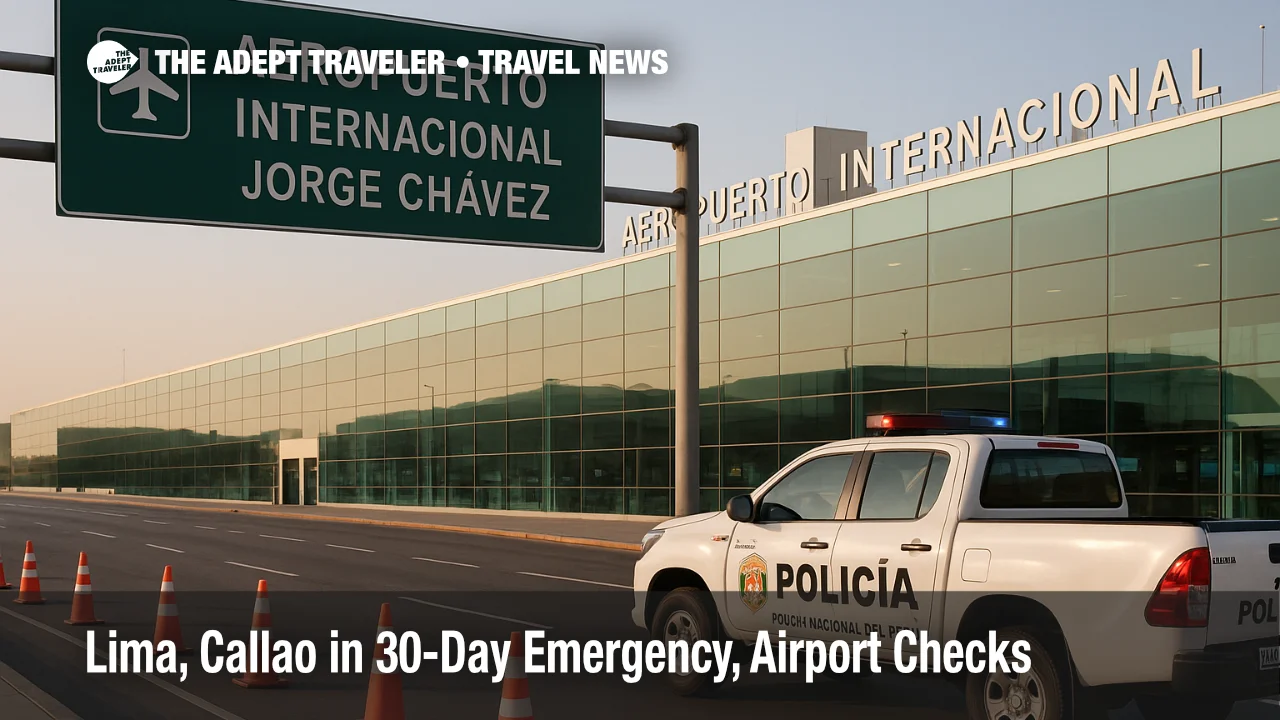Lima, Callao in 30-Day Emergency, Airport Checks

Key points
- Peru enacted a 30-day state of emergency for Metropolitan Lima and Callao starting October 22, 2025
- Travelers should expect ID checks, heavier patrols, and sporadic roadblocks on core corridors to Jorge Chávez International Airport
- The decree allows armed forces to support police and temporarily limits assembly while authorities target organized crime
- Carry a physical passport or government ID and build extra time into airport transfers, especially at peak hours
Impact
- Airport Transfers
- Plan longer curbside approaches and consider earlier departure windows for LIM drop offs
- Documentation
- Keep a passport or government ID on your person at all times for potential checkpoints
- Route Planning
- Use primary arterials first, have a rideshare or taxi fallback and confirm pickup points
- Demonstrations
- Avoid gatherings that could trigger police dispersal and swift movement restrictions
- Itinerary Flexibility
- Allow cushion for late arrivals and consider rebooking tight connections if inbound to LIM
Peru is enforcing a 30-day state of emergency across Metropolitan Lima and the neighboring Constitutional Province of Callao, in effect from October 22, 2025. The measure enables the armed forces to support police, increases street patrols, and brings ID checkpoints and intermittent roadblocks that can slow access to Jorge Chávez International Airport (LIM). Travelers should carry identification at all times and add buffer time to airport transfers through the end of the order, currently expected to run into the third week of November.
What changed and why it matters
The emergency order covers the capital's core districts and the airport province of Callao, Peru's main international gateway. Authorities cite a push against organized crime and extortion, with the decree empowering joint patrols and targeted operations. For travelers, the practical effect is procedural friction on key corridors, including the airport approach roads, where brief checks and lane closures can stack delays during peak periods.
Where the order applies
The scope is citywide for Metropolitan Lima and Callao, which together include the arterials most visitors use between central districts and the airport. While the government did not declare a curfew, the decree authorizes temporary restrictions on assembly and rapid interventions where public order is at risk. Expect a visible military and police presence in central areas, along coastal arterials, and on approaches to the airport perimeter.
Airport access and on-the-ground procedures
Approaches to Jorge Chávez can see rolling slowdowns as patrols pivot across lanes, set up short-duration controls, or funnel vehicles for spot checks. Rideshare and taxi pickups may be directed to specific bays. If you are transiting with tight schedules, consider departing earlier than usual, keep your passport within reach, and avoid routes that pass known protest sites or large gatherings. The U.S. Embassy warns that travelers should expect ID checks and heavier patrols during the order.
Legal basis and duration
The measure was formalized by Supreme Decree No. 124-2025-PCM, published in the official gazette El Peruano, and took effect just after midnight on October 22 for 30 days. Barring extension, that places the nominal end window around November 21, 2025. Any extension would require a fresh decree.
Background: How Peru's emergency orders work
A state of emergency in Peru temporarily shifts public-order responsibilities and can limit certain constitutional rights, including freedom of assembly and inviolability of domicile, within defined areas and timeframes. In practice, travelers mostly experience additional uniformed presence, mobile checkpoints, and faster dispersal of gatherings rather than blanket restrictions on movement. During the current order, the government has emphasized joint military-police operations to deter violent crime while keeping economic activity, including airport operations, running.
Practical routing tips for peak hours
If you are heading to the airport from the Miraflores, Barranco, or San Isidro hotel zones, leave earlier than normal and monitor live traffic to select the least congested coastal or express options. Ask your driver to favor well-lit arterials and official wayfinding around the airport campus. Keep bags closed, phones out of sight in traffic, and copies of your itinerary available. If you encounter a checkpoint, follow instructions, present ID promptly, and allow time for brief inspection so you can clear quickly.
Final thoughts
The state of emergency in Lima and Callao raises the chance of time-consuming checks on the roads, not a closure of the airport. With a passport on hand and a longer transfer window, most travelers can keep plans intact while authorities carry out security operations. Expect continued visibility of joint patrols until at least the week of November 18 to 21, when the current order would be due to lapse unless extended.
Sources
- Security Alert: State of Emergency in Lima and Callao (Oct 22, 2025) - U.S. Embassy Lima
- Peruvian Government declares state of emergency in Metropolitan Lima and Callao (Supreme Decree No. 124-2025-PCM) - Andina
- Peru declares 30-day state of emergency in Lima to tackle rising crime - Reuters
- Military and police patrol streets of Peru's capital as state of emergency begins - AP News
